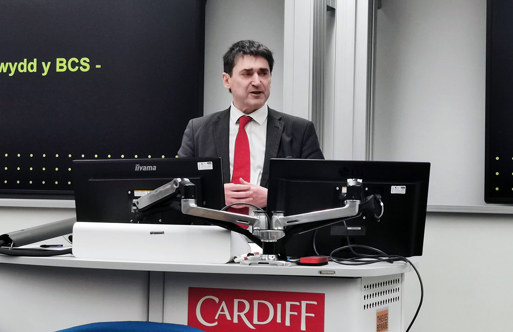 Click the image to enlarge
Click the image to enlargeCredit: Kelly Richardson, still from Mariner9, 2012.
Copyright the artist, reproduced with permission.
The red planet as we’ve never seen it before - littered with the detritus of long-forgotten expeditions, evidence of mankind’s once optimistic future reduced to scrap. It is an image inciting both trepidation and fascination in equal measures. This is the highly creative work of Kelly Richardson, our artist this month.
Featured here is a still from Mariner 9, a 12 meter-long panoramic digital video installation of Mars perhaps a century or two from now and a battlefield of real and imagined spacecraft in the centre of a dust storm.
The work has an extraordinary amount of detail, too much to do justice to on a webpage. This image shows a small detail; it is the NASA space rover Curiosity in an (imagined) semi-defunct state. (By clicking on the image, a full panoramic still will unfold.)
Of Canadian origin, Kelly now resides in North Tyneside and describes herself as a video installation artist creating landscapes that are part real, part unreal. They are usually filmed from existing locations and she inserts digital effects to make the landscape futuristic-looking.
Opening this month at the Northern Gallery for Contemporary Art Sunderland is a survey show of 15 years of her work. Her latest work, Mariner 9, was commissioned by The Pixel Palace (where she was artist in residence last year). It will be exhibited in Whitley Bay from 3 - 19 August and coinciding with the landing of NASA’s Mars Science Laboratory (aka ‘Curiosity’) on the planet early next month. After a two-year tour the work will be accessioned into the Laing Art Gallery’s permanent collection.
Kelly was looking to recreate Mars visually – actual and imagined, including some of the spacecraft that have made it to the planet, plus craft from other possible future missions. Wouldn’t it be marvellous to film on Mars? Instead Kelly used NASA’s digitised data collected from the planet.
This she combined with Terragen, scenery generating software known for producing photorealistic terrain. However she discovered that it was very difficult to get this data readable by the software and in particular faced challenges with achieving the texture she wanted. Ultimately she realised that the work is about making an artist’s presentation of a Martian landscape, rather than a completely faithful photorealistic reproduction.
Kelly has created an uber-realistic red planet, believably full of minute detail including distinctive geology, weather patterns, dust swirling around and even a soundscape. The artist worked with a sound designer to identify what the planet might sound like, based on NASA recordings of space.
The work consists of three projections 49 ft by 9 ft to create one continuous landscape that takes up the viewer’s entire peripheral view. Kelly explains that the installation and multi-channel projection needs to be large so that ‘people can get into the landscape and you can lose yourself in the work’ - an immersive experience.
From an art history perspective this has immediate parallels with the sublime - think of John Martin’s (1789-1854) huge canvases full of dramatic, fiery imagery as seen in the Tate Britain exhibition late last year. Artists inspired by the sublime intended to create an awe-inspiring experience for the viewer that was a combination of both the beautiful and the sinister aspects of nature.
Curator of the John Martin show Martin Myrone wrote, ‘Such spectacular visions have helped define the idea of the apocalypse for the modern age. The resonances with blockbuster cinema and computer games are obvious.’ With Mariner 9, Kelly presents an alternate past/future potential that is beautiful but unnerving; she comments that she is shifting the original ideas of the sublime into a future sublime, if you will.
Her interests lie ‘towards a digitalised world where the line between fact and fiction has become blurred. A collective anxiety about the future. Environmentally we are facing the greatest threat humanity has ever faced, yet we continue down a fixed path. And the psychological landscape which all of this produces.’
Coming from a traditional art background (Kelly has degrees in drawing and painting), she says her work now is about ideas rather than a focus on the medium (from 1997 she has worked mainly in video). This can entail a steep learning curve as she has to learn from scratch what is necessary in order to realise her vision for each new project.
Kelly points out that she uses software differently from the experts who tend to specialise and become deeply proficient in one aspect. Whereas she tends, she says to ‘flip from program to program’, learning a new program or aspect of one each time depending on what she wants to achieve.
Perhaps not surprisingly her research takes a long while and a large installation such as this can take up to a year and a half to realise. She prides herself on never going over old ground, but this means a continuous mastering of new sets of digital skills. However through this method she can approach each project with a freshness of mind and create fascinating new imagery.
Catherine Mason is the author of A Computer in the Art Room: the origins of British computer arts 1950-80, published in 2008.
More information on the Computer Arts Society, including our events programme

















